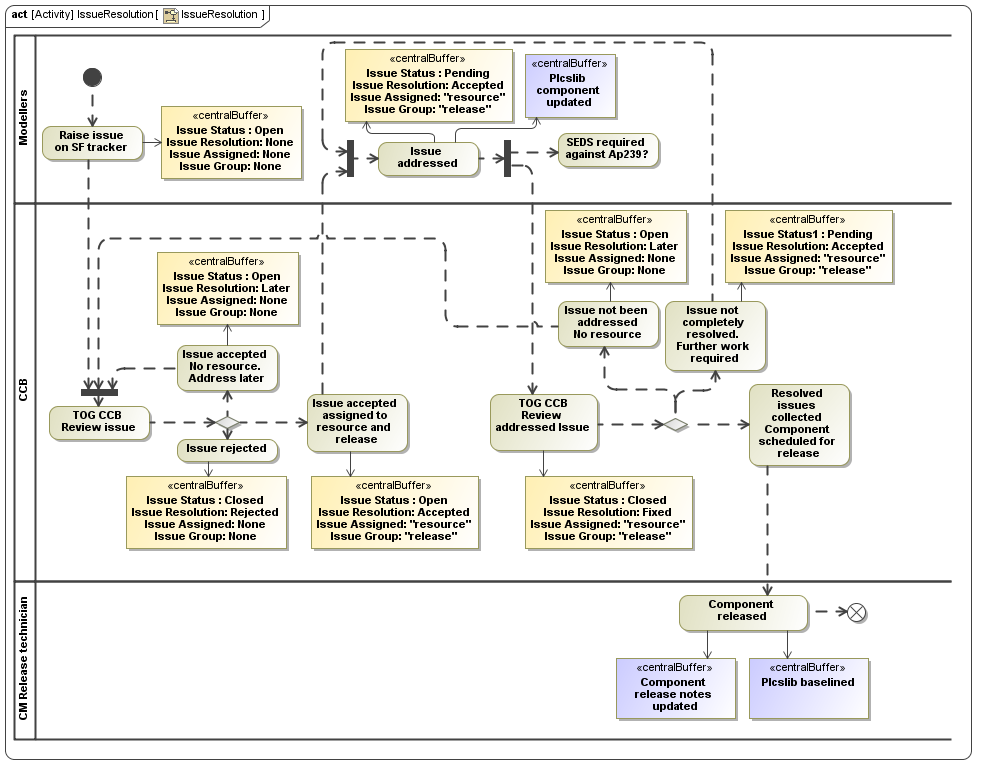During every development activity, problems that need to be resolved are identified. This could be either during initial development, or during a review of existing developed content. These identified problems are regarded as issues. An issue may be reported by anyone.
The PLCSlib Sourceforge project uses a "Tracker",
which supports both the creation of an issue, as well as the documentation of the
actions taken to resolve them
and their current numbers and respective status. In order to have access to the tracker,
the developer must be a registered Sourceforge user.
uses a "Tracker",
which supports both the creation of an issue, as well as the documentation of the
actions taken to resolve them
and their current numbers and respective status. In order to have access to the tracker,
the developer must be a registered Sourceforge user.
The following trackers, with categories, are available:
- PLCS PSMmodel
- Issues against the PLCS PSM model
- Concept model
- EXPRESS to XMI
- PLCS PSM Model
- PLCS PSM Schematron
- PLCS PSM XSD
- Issues against the PLCS PSM model
- PLCSlib infrastructure
- Issues against the PLCSlib infrastructure
- Help
- Terms
- XMI
- XSD
- XSLT
- Issues against the PLCSlib infrastructure
- PLCS templates
- Issues against the PLCSlib templates
- PLCS Ref. data
- Issues against PLCS reference data
- PLCS MUguide
- Issues against model usage guides
- PLCS DEX
- Issues against PLCS DXEs
The governance of issues is managed by the PLCS Change Control Board. Its relation to the OASIS PLCS TC is shown in Figure 2.
- Purpose:
- Review and agree resolution of issues
- Authorize & Implement changes to PLCSlib components
- Frequency
- Meet every Monday 14:00 UK time
- Governance:
- Chair: TOG Chair
- Open to all including non OASIS TC members – but they have no voting rights
- Decisions based on consensus
- If consensus not achieved, decision based on consensus by Core team
- If consensus not achieved by Core team – decision goes to vote, only CCB OASIS TC members can vote and one vote per organization
- If vote not decisive, Final decision made by TOG Chair
- Inform TC at each meeting of visibility and content of next release
- Responsible for release PLCSlib component under instruction from CCB
- Provide Technical oversight of PLCSlib
- Nominated technical experts
| Issue Status | Used to track status of Issue |
| Open | Issue raised |
| Closed | Issue resolved |
| Pending | Issue addressed but solution not signed off |
| Deleted | Issue deleted |
| #160; | #160; |
| Issue Resolution | Used to track issues resolution |
| Accepted | CCB accepted issue, assigned to a resource and set Group to a release so will be addressed |
| Rejected | CCB rejected issue |
| Later | CCB accepted issue , but no resource available, Group set to none |
| Fixed | Issue addressed, change reviewed and accepted |
| #160; | #160; |
| Issue Group | Used to track releases issues assigned to |
| None | Issue not assigned to a release |
| R1 | CCB accepted issue and assigned to a release R1 |
The process for raising and processing issues is shown in Figure 3.
Email lists
RSS
When an issue has been identified, it needs to be properly reported in order for the other members of the PLCS organisation to be able to track the actions taken to resolve the issue.
Before adding an issue to any of the trackers, it is useful to look through the existing issues. This reduces the chance of the same problem being described as more than one issue.
These steps are needed in order to add an issue to a tracker:
- chose the appropriate tracker from the "Tracker" drop down menu
- click on the link "Add new"
- chose the correct category (if available)
- chose who to assign the issue to, if unsure, leave it as it was
- indicate priority 1-9, where 9 is the highest priority, i.e. most important
- write a descriptive title for the issue
- further describe the problem that needs to be addressed, possibly with suggestions, guidance or directives concerning how this need to be done
- if relevant, upload a file that could support the understanding or resolving of the identified problem
- click the "Add Artefact" button to commit the issue
The trackers should be the place where technical discussions concerning issues take place. Discussions in e-mail are much harder to go back to when trying to understand what led to a particular solution to a specific problem and should therefore be avoided. The following steps are needed to comment on an open issue:
- locate the issue to comment
- type in the comment in the "Comment" text field
- click the "Update" button to commit your comment
When actions has taken to resolve the problem being registered as an issue that includes modifying any of the PLCSlib files, the following steps should be taken.
(while committing the changed file)
- make the change of the file or files that rectify the problem
- copy the url of the web page of the issue
- commit the file(s) to which change has been made and post the link to the issue along with it
- copy the message presented by your CVS or SVN tool as a result of the commit process showing what files of what versions were modified
(at the Sourceforge tracker)
- describe the actions taken to resolve the issue in the "Comment" text field
- paste the CVS or SVN tool message in the same text field
- change status to "pending" if the actions taken completely solved the problem and it is ready for CCB review
- click the "Update" button to commit your changes







